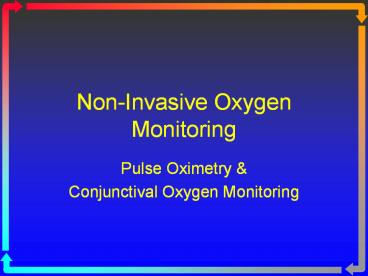Non-Invasive Oxygen Monitoring - PowerPoint PPT Presentation
Title:
Non-Invasive Oxygen Monitoring
Description:
On the opposite side of the LEDs, there is a photodetector. This photodetector measures the amount of light that is absorbed at each of the two wavelengths, ... – PowerPoint PPT presentation
Number of Views:257
Avg rating:3.0/5.0
Title: Non-Invasive Oxygen Monitoring
1
Non-Invasive Oxygen Monitoring
- Pulse Oximetry
- Conjunctival Oxygen Monitoring
2
OBJECTIVES
- At the end of this module, the student will be
able to - define terms associated with pulse oximetry.
- explain the theory of operation of a pulse
oximeter. - differentiate between functional and fractional
saturation. - list the indications, limitations, advantages,
disadvantages and contraindications for use of a
pulse oximeter.
3
OBJECTIVES
- At the end of this module, the student should be
able to - list some of the things that affect the accuracy
of a pulse oximeter. - explain when co-oximetry would be more
appropriate than pulse oximetry. - describe patient application for each of the
noninvasive monitors.
4
ASSIGNMENTS
- Read
- Egan Chapter 16, pgs. 377 383
- AARC Clinical Practice Guidelines - Pulse
Oximetry - Articles on Pulse Oximetry (look on website)
5
Circle of Oxygenation
Lungs Uptake PaO2 Dissolved Oxygen
Tissues Utilization ?O2 Oxygen Consumption
Blood Carrying SaO2 Carried Oxygen
Heart Pumping DO2 Oxygen Delivery
6
Hypoxia Develops Rapidly
98
97
96
95
SaO2
PaO2 mmHg
? 4 gt 2 L/min
A
90
80
Central Apnea
70
Obstructive Apnea
50
30
Hypoxia Obstructive Apnea
10
0
1
2
3
4
from Hanning,"Oximetry and Anaesthetic Practice",
1985
7
Pulse Oximetry
- The Fifth Vital Sign
8
Oxygen Content
- The total amount of oxygen present in arterial
blood. - Dissolved oxygen (PaO2)
- Attached to hemoglobin (SaO2)
- Measured by co-oximeter
- Estimated by pulse oximeter
- Calculated by blood gas analyzer
- Actual amount of hemoglobin (Hb)
9
Oxygen Carrying Capacity
10
The Science behind Oximetry
- Spectrophotometry
- Lambert-Beer Law
- Light Transmission Spectra and Oximetry
- Light Emitting Diode (LED) technology
- Optical Plethysmography
11
Spectrophotometry
- Spectrophotometry is the measurement of the
amount of light that is absorbed as it passes
through a substance. - Reflected
- Absorbed
- Transmitted
- Spectrophotometry is an application of Beers
(Beer-Lambert) law.
12
Absorption Spectrum
13
Schematic block diagram of a pulse oximeter
14
Wavelength Selection
- Two wavelengths are selected for analysis.
- A red light at about 660 nanometers (nm).
- An infrared light at about 940 nanometers.
- So how do we get such specific measurements?
15
Light Emitting Diode Technology
- A pulse oximeter sensor is made up of two
different parts - An light emitting diode
- A photodetector
16
Misalignment of the sensor by inserting finger
too far.
17
Optical Plethysmography
- Plethysmography is the measurement of changes in
volume in a particular part of the body. - Originally designed to measure vascular
perfusion. - Changes in volume at a site is due to the
pulsation of arterial blood.
18
Output signal generated by pulse oximeter.
Saturation is based on the ratio of light
absorption during pulsatile and baseline phases.
19
Functional vs. Fractional Saturation
- SpO2 ¹ SaO2
- Functional Saturation (SpO2)
- Fractional Saturation (SaO2)
20
Measurement vs. Monitoring
- Measurement A one time snapshot. Example ABG
sample or a spot-check SpO2. - Monitoring Ongoing measurements.Example
Continuous pulse oximetry
21
Golden Rule For Safety Monitors
- A Safety Monitor must be
- RELIABLE
- CONVENIENT
- SAFE
- ACCURATE
Always detect danger and No false goodness
22
Technical Limitations
- Calibration Assumptions
- Optical Interference
- Absorption Interference
- Signal Artifact
23
Calibration Assumptions
- Calibration curves
- Accuracy range
24
Optical Interference
- Ambient Light
- Optical Shunt
- Optical Cross-Talk
- Edema
25
Absorption Interference
- Anemia
- Skin Pigmentation
- Nail Polish
- Carbon Monoxide
- Methemoglobin
- Intravascular Dyes
26
Signal Artifact
- Artifact can cause errors in measurement.
- Artifact may obscure the signal
- Causes
- Low perfusion
- Hypotension
- Cold
- Motion Artifact
27
(No Transcript)
28
The Solution?
- Improvements in technology that
- Improve the signal to noise ratio present in low
perfusion. - Improve the ability of the oximeter to read
through motion.
29
Sensor Application
- Properly place sensor.
- Single use sensor are meant for a single patient.
- Use sensor as designed.
30
Patient Application - Sites
- Adults children
- Finger
- Toe
- Ear lobe
- Cheek
- Tongue
- Nose
- Small children babies
- Wrist
- Upper arm
- Across foot
31
Pulse oximetry probes
32
(No Transcript)
33
Reporting Results
- Four things to verify prior to reporting results
- Waveform
- Signal strength
- Heart rate
- Clinical Correlation
34
Plethysmograph Pulse oximeter tracing
35
Oxyhemoglobin Dissociation Curve
36
Contraindications (relative)
- When arterial blood gases are indicated for
measurement of pH or PaCO2. - When CO-oximetry is indicated for evaluation of
total hemoglobin and abnormal hemoglobins - HbCO
- HbMet
37
Maintenance
- Pulse oximeters usually do a self-check when they
are first turned on. - They do not require regular routine manual
calibration. - Wipe probe and monitor with an alcohol soaked
cloth between patients.
38
Mini Clini - Egan Page 363
39
Conjunctival
- Principles of Operation
- A sensor is inserted under the eyelid.
- It contains a Clark PO2 electrode similar to a
blood gas analyzer. - It is used mainly in to OR for short-term
application. - Conjunctival PO2 is reported and correlates to
the arterial PaO2.
40
Conjunctival PO2 (PcjO2)































